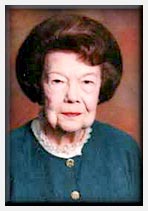Pampa High School Is Appreciated by Students |
|
 Eloise Lane
Eloise Lane
Returning students often express gratitude for the education they received in Pampa High School, and several classes have made significant contributions to the school to show their appreciation. The class of 1944 instigated the project of landscaping and beautification which has made the campus so attractive. A marker has been placed on the south lawn of the campus. The class of 1957 donated trophy cases to display photographs and biographies of the members of the Harvester Hall of Fame. These cases are placed in the main hall of the high school building. The class of 1948 presented to the school a large map showing the Gray County part of Captain Randolph B. Marcy's expedition to trace the Red River to its source. This display, "Expedition of 1852," hangs in the gallery of the White Deer Land Museum. The map was researched and compiled by Richard B. Hughes, Tom Chisholm, Don Lane and Ann Campbell. In 1852 Captain Marcy was ordered to examine the country between the mouth of Cache Creek (near present Fort Sill) to the source of Red River. Marcy's account of his Red River exploration contains one of the most accurate and lucid descriptions of of a portion of the Great Plains ever printed as a government document. Marcy's command entered eastern Wheeler County on June 10 and Marcy found the Panhandle abundant in fresh water, beauty, game, wild fruits and onions, and wide spread signs of Indian war parties. The camp of June 12 was near the site where Fort Elliott was located later, and the explorers entered eastern Gray County on June 14. On June 16, Marcy's party reached the head of the North Fork and camped in a grove of cottonwood trees near present Lefors. On the largest tree Marcy carved an inscription: "Exploring Expe- dition, June 16, 1852." Under the tree he buried a bottle containing a memorandum stating that he and his party had traced the Red River to its source. Marcy realized that he was near the Canadian River which he had explored three years previously in 1849, and he was anxious to establish the relationship between the Red and Canadian Rivers. With a selected party the Captain struck northward across the Staked Plains "where the eye rests on no object of relief within the scope of vision," A march of 25 miles led to a point on the Canadian which he immediately recognized. Having established that the Red River and the Canadian River were two separate rivers, Marcy returned to his main party at North Fork. On June 25 the entire command moved 12 miles southward toward the Salt Fork. They came to a small stream of sweet water that Marcy named McClellan's Creek because he believed McClellan "to be the first white man that ever set eyes on it." Brevet Captain George B. McClellan, an engineer, was second in command to Marcy and later became Marcy's son-in-law. A state historical marker, dedicated in 1985, has been placed five miles south of Pampa on State Highway 70. The class of 1956 sponsored the bronze Harvester statue unveiled on the south lawn of the Pampa High School campus in October 2001. This 7-foot-high statue depicts a wheat farmer surveying his land near the turn of the century and represents the spirit of a true Harvester who is determined to succeed in spite of difficulties. Ted Swindle, vice president of the class, explained that the statue is a tribute to all who have been a part of Pampa High School with "memories of the past, excitement of the present and accomplishments of the future."
Granite blocks below the statue are being sold for honorariums and memorials to prov1de~f or `Pampa High School graduates. It. is hoped that each graduating class will make a donation, adding its name to the plaza.
So far the largest donation has been made by the class of 1950 -- this is second only to the sponsoring class of 1956 in acquiring funds for scholarships. The class of 1950 purchased an 18-inch statue to present to the White Deer Land Museum in honor of the Gray County Centennial. This statue, costing $2,000, is numbered 5/50 in a limited edition. The statue is placed on a pedestal of birch wood made by Jim Davidson. The Pedestal has a beveled marble top made in Amarillo. Joan Stroup Brown, Joyce Jones Hutsell and Beverly Friauf made the arrangements by telephone and e-mail. In January of 2002, Hutsell of Groom came to the museum for the dedication of the statue on the pedestal.
Granite blocks below the statue are being sold for honorariums and memorials to prov1de~f or `Pampa High School graduates. It. is hoped that each graduating class will make a donation, adding its name to the plaza.
So far the largest donation has been made by the class of 1950 -- this is second only to the sponsoring class of 1956 in acquiring funds for scholarships. The class of 1950 purchased an 18-inch statue to present to the White Deer Land Museum in honor of the Gray County Centennial. This statue, costing $2,000, is numbered 5/50 in a limited edition. The statue is placed on a pedestal of birch wood made by Jim Davidson. The Pedestal has a beveled marble top made in Amarillo. Joan Stroup Brown, Joyce Jones Hutsell and Beverly Friauf made the arrangements by telephone and e-mail. In January of 2002, Hutsell of Groom came to the museum for the dedication of the statue on the pedestal.

